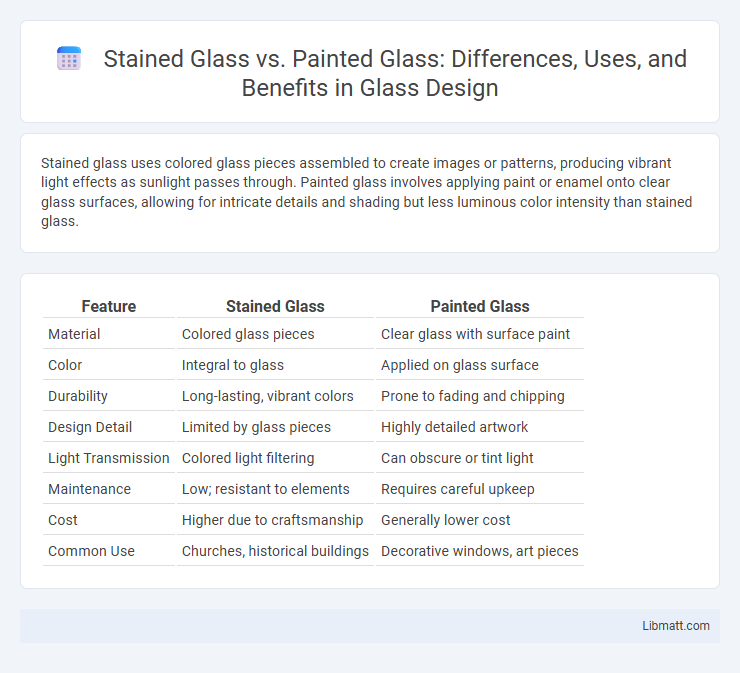Stained glass uses colored glass pieces assembled to create images or patterns, producing vibrant light effects as sunlight passes through. Painted glass involves applying paint or enamel onto clear glass surfaces, allowing for intricate details and shading but less luminous color intensity than stained glass.
Table of Comparison
| Feature | Stained Glass | Painted Glass |
|---|---|---|
| Material | Colored glass pieces | Clear glass with surface paint |
| Color | Integral to glass | Applied on glass surface |
| Durability | Long-lasting, vibrant colors | Prone to fading and chipping |
| Design Detail | Limited by glass pieces | Highly detailed artwork |
| Light Transmission | Colored light filtering | Can obscure or tint light |
| Maintenance | Low; resistant to elements | Requires careful upkeep |
| Cost | Higher due to craftsmanship | Generally lower cost |
| Common Use | Churches, historical buildings | Decorative windows, art pieces |
Introduction: Stained Glass vs Painted Glass
Stained glass consists of colored glass pieces arranged in patterns and held together by lead strips, creating vibrant light effects in windows. Painted glass involves applying pigments or enamels directly onto clear glass, offering detailed imagery but less light transmission. Both techniques serve decorative and narrative purposes in architecture and art, with stained glass emphasizing color and light interplay, while painted glass prioritizes intricate designs.
Historical Overview of Glass Art
Stained glass dates back to medieval Europe, where artisans created vivid religious scenes using colored glass pieces held together by lead cames, becoming a hallmark of Gothic cathedrals. Painted glass, which involves applying vitreous paint onto clear glass and firing it to fuse the design, emerged during the Renaissance, allowing for more detailed and realistic imagery. Understanding the evolution of these art forms highlights their distinct techniques and cultural significance, enhancing your appreciation of glass art history.
Materials and Techniques Used
Stained glass is created by arranging pieces of colored glass, often held together by lead cames, and then soldered to form intricate designs, while painted glass involves applying vitreous paints or enamels onto clear glass surfaces, which are then kiln-fired to fuse the paint. Materials used in stained glass include silica, potash, and metal oxides for coloration, with the glass cut and shaped before assembly, whereas painted glass relies on pigments mixed with a glass flux that vitrifies upon firing. Techniques in stained glass emphasize cutting, leading, and assembling, contrasting with the brushwork and firing process essential to painted glass artistry.
Visual Differences and Characteristics
Stained glass features vibrant, translucent colors created by adding metallic salts during glass production, resulting in rich hues that change with light exposure. Painted glass uses enamel paints applied to clear glass surfaces, allowing for detailed imagery and shading but often lacks the luminosity and depth seen in stained glass. Your choice depends on whether you prefer bold, colorful light effects or intricate painted designs with fine details.
Durability and Maintenance
Stained glass offers superior durability compared to painted glass due to its colored glass pieces fused with lead cames, making it resistant to fading and weathering. Painted glass, relying on surface-applied pigments, often requires regular maintenance to prevent deterioration from UV exposure and moisture. Your choice impacts long-term upkeep costs, with stained glass demanding less frequent restoration for lasting vibrancy.
Artistic Applications and Styles
Stained glass art utilizes colored glass pieces joined by lead came creating luminous designs ideal for ecclesiastical and architectural settings, emphasizing light interaction and vibrant hues. Painted glass involves applying enamel or vitreous paint to clear or lightly tinted glass, allowing for detailed imagery and shading suited to narrative scenes and portraiture. Both techniques offer distinct artistic styles: stained glass excels in abstract patterns and symbolic motifs, while painted glass supports realism and fine line work.
Cost Comparison: Stained vs Painted Glass
Stained glass generally has a higher upfront cost due to intricate craftsmanship and quality of colored glass, while painted glass tends to be more affordable as it involves surface application of pigments. Maintenance expenses for stained glass can be lower over time since colors are integral to the glass, contrasting with painted glass that may require frequent touch-ups or repainting. Your choice impacts budget allocation, balancing initial investment against long-term care and artistic value.
Common Uses and Architectural Integration
Stained glass is commonly used in churches, cathedrals, and historic buildings to create vibrant, colorful windows that filter light and convey religious or symbolic imagery. Painted glass often appears in decorative panels, portraits, and smaller accent pieces, allowing for detailed designs that complement furniture or interior spaces. Architecturally, stained glass serves as structural elements in large window installations, while painted glass is integrated into ornamental features, enhancing aesthetic appeal without compromising light transmission.
Pros and Cons of Each Method
Stained glass offers vibrant colors and durability thanks to colored glass pieces held by lead cames, but it requires skilled craftsmanship and is often costly to produce and install. Painted glass allows for intricate details and shading using glass paint and firings, making it ideal for fine artwork, though it is more susceptible to wear and fading over time. Each method balances aesthetic appeal and longevity differently, influencing its suitability based on project requirements and budget.
Choosing the Right Glass for Your Project
Choosing between stained glass and painted glass depends on your project's aesthetic and functional requirements. Stained glass offers vibrant, long-lasting colors created by embedding metallic salts during the glass-making process, ideal for classic or traditional designs. Painted glass allows for detailed, artistic imagery with the flexibility of overlaying colors, perfect for custom scenes or modern installations tailored to your vision.
stained glass vs painted glass Infographic

 libmatt.com
libmatt.com